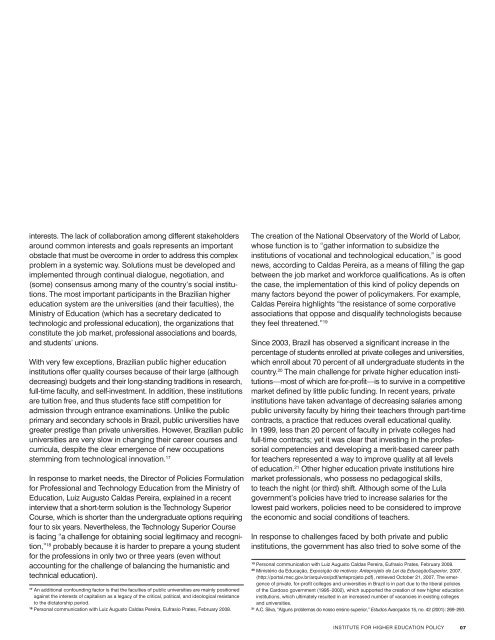Educational Policies for Integrating College Competencies and ...
Educational Policies for Integrating College Competencies and ...
Educational Policies for Integrating College Competencies and ...
Create successful ePaper yourself
Turn your PDF publications into a flip-book with our unique Google optimized e-Paper software.
interests. The lack of collaboration among different stakeholdersaround common interests <strong>and</strong> goals represents an importantobstacle that must be overcome in order to address this complexproblem in a systemic way. Solutions must be developed <strong>and</strong>implemented through continual dialogue, negotiation, <strong>and</strong>(some) consensus among many of the country’s social institutions.The most important participants in the Brazilian highereducation system are the universities (<strong>and</strong> their faculties), theMinistry of Education (which has a secretary dedicated totechnologic <strong>and</strong> professional education), the organizations thatconstitute the job market, professional associations <strong>and</strong> boards,<strong>and</strong> students’ unions.With very few exceptions, Brazilian public higher educationinstitutions offer quality courses because of their large (althoughdecreasing) budgets <strong>and</strong> their long-st<strong>and</strong>ing traditions in research,full-time faculty, <strong>and</strong> self-investment. In addition, these institutionsare tuition free, <strong>and</strong> thus students face stiff competition <strong>for</strong>admission through entrance examinations. Unlike the publicprimary <strong>and</strong> secondary schools in Brazil, public universities havegreater prestige than private universities. However, Brazilian publicuniversities are very slow in changing their career courses <strong>and</strong>curricula, despite the clear emergence of new occupationsstemming from technological innovation. 17In response to market needs, the Director of <strong>Policies</strong> Formulation<strong>for</strong> Professional <strong>and</strong> Technology Education from the Ministry ofEducation, Luiz Augusto Caldas Pereira, explained in a recentinterview that a short-term solution is the Technology SuperiorCourse, which is shorter than the undergraduate options requiringfour to six years. Nevertheless, the Technology Superior Courseis facing “a challenge <strong>for</strong> obtaining social legitimacy <strong>and</strong> recognition,”18 probably because it is harder to prepare a young student<strong>for</strong> the professions in only two or three years (even withoutaccounting <strong>for</strong> the challenge of balancing the humanistic <strong>and</strong>technical education).17An additional confounding factor is that the faculties of public universities are mainly positionedagainst the interests of capitalism as a legacy of the critical, political, <strong>and</strong> ideological resistanceto the dictatorship period.18Personal communication with Luiz Augusto Caldas Pereira, Eufrasio Prates, February 2008.The creation of the National Observatory of the World of Labor,whose function is to “gather in<strong>for</strong>mation to subsidize theinstitutions of vocational <strong>and</strong> technological education,” is goodnews, according to Caldas Pereira, as a means of filling the gapbetween the job market <strong>and</strong> work<strong>for</strong>ce qualifications. As is oftenthe case, the implementation of this kind of policy depends onmany factors beyond the power of policymakers. For example,Caldas Pereira highlights “the resistance of some corporativeassociations that oppose <strong>and</strong> disqualify technologists becausethey feel threatened.” 19Since 2003, Brazil has observed a significant increase in thepercentage of students enrolled at private colleges <strong>and</strong> universities,which enroll about 70 percent of all undergraduate students in thecountry. 20 The main challenge <strong>for</strong> private higher education institutions—mostof which are <strong>for</strong>-profit—is to survive in a competitivemarket defined by little public funding. In recent years, privateinstitutions have taken advantage of decreasing salaries amongpublic university faculty by hiring their teachers through part-timecontracts, a practice that reduces overall educational quality.In 1999, less than 20 percent of faculty in private colleges hadfull-time contracts; yet it was clear that investing in the professorialcompetencies <strong>and</strong> developing a merit-based career path<strong>for</strong> teachers represented a way to improve quality at all levelsof education. 21 Other higher education private institutions hiremarket professionals, who possess no pedagogical skills,to teach the night (or third) shift. Although some of the Lulagovernment’s policies have tried to increase salaries <strong>for</strong> thelowest paid workers, policies need to be considered to improvethe economic <strong>and</strong> social conditions of teachers.In response to challenges faced by both private <strong>and</strong> publicinstitutions, the government has also tried to solve some of the19Personal communication with Luiz Augusto Caldas Pereira, Eufrasio Prates, February 2008.20Ministério da Educação, Exposição de motivos: Anteprojeto de Lei da EducaçãoSuperior, 2007,(http://portal.mec.gov.br/arquivos/pdf/anteprojeto.pdf), retrieved October 21, 2007. The emergenceof private, <strong>for</strong>-profit colleges <strong>and</strong> universities in Brazil is in part due to the liberal policiesof the Cardoso government (1995–2002), which supported the creation of new higher educationinstitutions, which ultimately resulted in an increased number of vacancies in existing colleges<strong>and</strong> universities.21A.C. Silva, “Alguns problemas do nosso ensino superior,” Estudos Avançados 15, no. 42 (2001): 269–293.INSTITUTE FOR HIGHER EDUCATION POLICY07

















